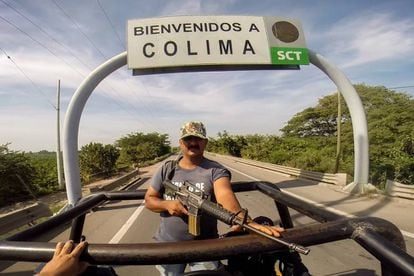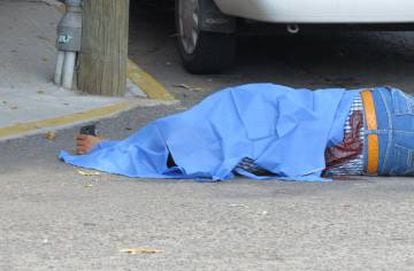Why once-peaceful Colima is now gripped by an epidemic of violence
War between drug cartels has made Mexico’s tiny Pacific tourist state the country’s bloodiest region
Outside the bus station in Colima, the capital city of the state of the same name, a large sign reads: “We’re cleaning up Colima.” It’s a reference to a municipal recycling program and a sign of modernity still relatively rare in much of Mexico.

This is Colima, a state pitched by tourist guides as a haven of tranquility with one of the country’s best standards of living, long stretches of unspoiled beach and temperatures averaging a perfect 25ºC, providing the basis for a sustainable tourist industry. Colima’s economy further benefits from having the largest port, Manzanillo, on Mexico’s Pacific coast, and it even has an active volcano that keeps geologists across the globe in thrall.
But over the course of this year, violence has taken hold of Colima.
“Bar shootout leaves one dead and two wounded,” read a headline from the local newspaper last week. “Thirty-year-old man killed in his car,” runs another, below it a column begins: “Body found on motorway.”
They have left us to deal with this alone Guadalupe García, Mayor of Tecomán
Since the beginning of 2016, Colima has been increasingly caught up in a spiral of violence triggered by Mexico’s two most powerful drugs cartels, turning it from the country’s most peaceful state to its most violent.
Located on the Pacific coast just 20 hours from the US border by car, it’s one of Mexico’s smallest and least-populated states, covering an area four times the size of Mexico City, but with just 700,000 inhabitants.
“The state has traditionally been a place where visitors come to relax and where criminal organizations come to launder money,” explains Vidal Llerenas, a deputy from Morena, the left-wing political party led by Andrés Manuel López Obrador. “Recently, it has come under the control of the Jalisco Nueva Generación (CJNG) drug cartel.”
In 2015, the outfit that previously controlled Colima’s drugs trade, Sinaloa drug cartel, headed by Joaquín El Chapo Guzmán, posted on its Facebook page that it was going to rid the state of the CJNG. According to the page, which has since been taken down, representatives of Guzmán, now in prison and awaiting extradition to the United States, had met with members of the Familia Michoacana cartel to “strengthen alliances and reach agreement to continue to protect the public ... Extortionists, rapists, kidnappers, bandits, and members of CJNG will be exterminated,” it said. “Sinaloa is already in Colima.”

Codenaming the operation “Sweeper,” the Sinaloa cartel and its allies then triggered a turf war.
With more than 550 murders this year and a murder rate of 89 for every 100,000 inhabitants – almost six times the national average, Colima is now Mexico’s most violent state.
Most of the killing in Colima is taking place in Tecomán, the state’s third-largest city. The city’s mayor, Guadalupe García, adjusts his cowboy hat and says: “We are very worried, and I want to take advantage of the opportunity of speaking to this prestigious paper to ask President Peña Nieto to intervene and get to the bottom of things here in Tecomán,” he told EL PAÍS.
The mayor was woken the day before with news of yet another corpse that had been dumped in front of the police station and while talking to this reporter, was told another had been found. The annual body count in the city is 116 for every 100,000 residents – more than Acapulco or Iguala in Guerrero, previously the murder capitals of Mexico. “They have left us to deal with this alone,” says García.
Sitting between the border with Michoacán and the port of Manzanillo, Tecomán’s plentiful supply of immigrant labor – mainly poor peasants who have come from the countryside to find work – make it strategically significant to Mexico’s drug cartels.

“We are overwhelmed and something has to be done to tackle this problem,” insists García. “It’s not enough just to have a police presence and set up roadblocks. There has to be a greater intelligence effort.”
— Which cartels are operating in the region?
— It’s not up to me to name them.
— What about corruption among the local police, a charge made by government secretary Miguel Ángel Osorio Chong?
— That needs to be proved. There is also corruption in the government and the military.
One man who has considerable personal experience of the violence assailing the town is the taco vendor next to the police station: in the last month, he’s had to barricade himself into his establishment on three occasions and sit out firefights.
“The police get a lot of threats,” he says. “And when they think something is going to happen, they put snipers on the rooftops and cut the traffic so the public don’t get hurt. They are very jumpy. In the last 15 days, three policemen have been killed in cold blood.”
Manzanillo, the state’s second-biggest city, is fading fast. It still bears some of the signs of its once-elegant past but is in need of more than a lick of paint.
To add to the state’s woes, Washington earlier this year issued a security warning to its citizens about the dangers of Mexico. “The Americans hear the words violence and Mexico and don’t distinguish between one region and another,” says Carlos Arellano, president of the local hotel association. “They tar everything with the same brush, unlike tourists from Canada and Europe who continue to come as usual.” This Christmas hotel occupancy is around 85%, he says.
Colima has traditionally been a place where visitors come to relax and where criminals come to launder money
Manzanillo is the jewel in Colima’s crown. The city’s tourism and port activity accounts for 75% of the state’s income – the rest comes from the export of lemons, avocados and paw paws to the United States. Its maritime infrastructure is the most important on Mexico’s Pacific coast, providing a gateway to China. It is, in effect, a mini city that creates half of the state’s jobs and moves 2.5 million containers annually.
“Since the port of Lázaro Cárdenas in Michoacán was put under military control in 2013, the movement of illegal substances has shifted to Manzanillo,” says Guillermo Valdés, a former director of the CISEN intelligence agency, referring to the import of the chemicals used in the manufacture of methamphetamine. “These chemicals mainly come from China and the only way to import them is in containers. It’s not like cocaine that can be moved on speed boats and dropped at any beach,” he says.
Surrounded on either side by Jalisco and Michoacán, Colima has until now escaped the violence that has dogged its neighbors. When that began to change, people assumed the drug cartels would at least keep the killing among themselves.
In recent months, however, couples kissing on the street, students and policemen have been murdered with the same impunity as drug-dealers and the cartel vigilantes. There has also been a dizzying rise in the number of burglaries, kidnappings and car thefts. “After saying again and again that nothing happens here, the cartels cottoned on and took over,” says Arellano.

Many residents of Colima now look to Michoacán, previously the source of all their problems, for inspiration in how to tackle the violence. On the border between the two states, in the town of Coahuayana, a group of 120 men and women have decided to take a stand against the cartels, setting up a self-defense unit. “Colima has ended up with the trash we chased out of Michoacán,” says one of their number, who calls himself Comandante Teto. “The survivor of the Familia and Templarios cartels joined the CJNG,” he explains.
Other self-defense groups were disbanded by the authorities and their leaders either co-opted or jailed, but Teto and his followers have persevered and now head a small army that watches over their town around the clock to fend off Los Viagra, another violent group that kill and rob in the area.
Consequently, the town of 18,000 people has seen crime reduced practically to zero while Teto fields calls from businessmen interested in financing self-defense groups in Colima.
“Before, we were scared to go to Michoacán; now we are scared to live in Colima,” says a local businessman who asks for anonymity. He has decided to grow his paw paws over the border because of the protection he gets from the self-defense groups there.
Over the course of the last week, two new corpses were dumped each in waste ground. Cleaning up Colima has come to mean something far more gruesome than simply recycling.
English version by Heather Galloway.













































